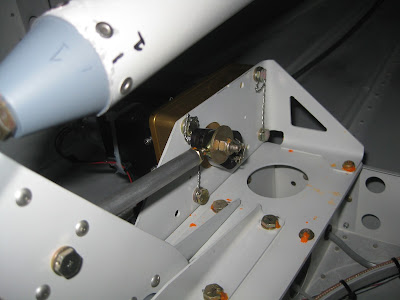My GRT roll servo kept slipping in smooth, level flight. This was even with the (electronic) torque setting at its highest. Eventually, the servo sheared its own shear screw in flight. So I took the opportunity to start a conversation with GRT about what the issue might be. That conversation led me to send in my servo to have it checked out by their technician. It was returned to me stating that it was functioning properly.
After I received my servo back from GRT, I decided to remove the sheared shear screw. It's a 6-32 screw, so I drilled it out with a slightly smaller drill bit (left) then used a tap to work out the remaining material (right).
Next, I decided to try attaching the servo control rod to the servo arm in the middle hole. This affords more torque but less throw, as shown below. In flight, the roll servo slipped less but slipped none-the-less. So I finally connected the control rod in the minimum throw/maximum torque location (ensuring that the control rod length was adjusted to provide proper servo shaft angles). In flight, the servo rarely slips. I am still trying different gain and damping settings. I hope to "tune out" the slipping as it seems to slip mainly in turbulence now.
I had to do the same with the pitch servo (below) aft it slipped in flight when trimmed properly (boy did that wake me up!). Right now I am flying it on the middle hole of the servo arm.
As an aside, I'm not sure why the roll servo slips at all. It's the high torque version that GRT provides for the RV-10. That airplane has the same wing as the RV-14 and apparently has heavier roll control. The few blogs I've been able to find of GRT-equipped RV-10s all show their roll servos with the maximum throw/minimum torque setup. To my knowledge, I'm the only RV-14A flying behind GRT.





No comments:
Post a Comment